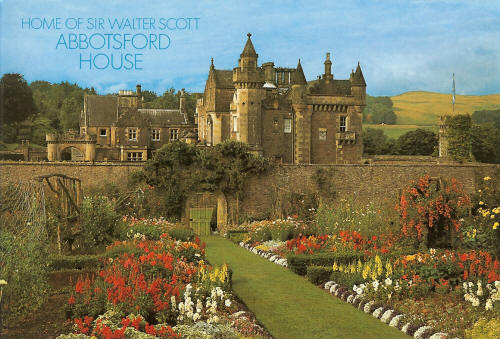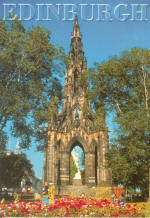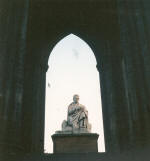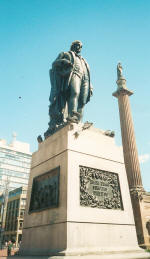|
By Kay Shaw Nelson
email:
jurascot@earthlink.net


Sir Walter Scott, one of the
most prolific beloved writers of all time, author of many notable novels and
narrative poems, was also a social historian who had a keen interest in
Scotland’s food and gastronomic traditions. Early in the 19th
century, there was a notable renaissance in Edinburgh and the Lowlands of
old Scots’ dishes and dining customs that were looked upon with new respect,
and “The Whole World’s Darling” did a great deal to foster and promote the
revival of Scottish self-awareness and make people proud once again to be
Scots. It has been said that if ever a man was a publicity agent for
Scotland, it was Scott.

While some persons may consider the gastronomic world of Scots to be of
trifling importance, it is interesting to consider a few references in his
notable works in which the acclaimed author welded the Highland and Lowland
culinary traditions to achieve a heightened awareness of the past and make
the rest of the world take notice. He gave us a wealth of valuable and
fascinating information for food historians and devotees of Scottish
gastronomic lore.
Scott’s tastes in food were said to be plain and Scottish, and he maintained
a lively interest in foods that were grown in his country, regional fare,
and is known to have enjoyed the conviviality of fine dining in his home, at
clubs, and while traveling. “The Wizard of the North” was familiar with the
kitchens of royalty, aristocrats, and crofters.
Revered as “probably the greatest storyteller that Scotland ever produced,”
in his tales of adventure and intrigue with colorful characters and great
descriptions of everyday life and special occasions, Scott was a marvel at
depicting Scottish manners, dialect, and persons of note being those with
which the author was most intimately and familiarly acquainted. Through his
professional studies, Scottish history, antiquity, and walking expeditions
into the Highlands and the Borders Country, Scott acquired an immense
knowledge of local legends, people and their daily lives that went into the
writing of his ballads and novels.
In
1824 Scott wrote that he only ate twice a day – a “bountiful” breakfast and
a “very moderate” dinner. In his novels we can easily trace the evolution of
the Scottish breakfast that has been acclaimed as one of Scotland’s most
notable repasts and one that Scott fondly extols in detail.
At
Abbotsford House in the Borders where the author lived the life of a country
magistrate and the landowner, his breakfast, served about nine, is said to
have comprised porridge with cream, “salmon, fresh or kippered,” “a
home-made ham, a pie, or a cold sheep’s head,” followed by “oatcakes, or
slices of brown bread spread thick with butter.”
In
Old Morality (1816), Scott’s truest historical novel, there is an
inviting description of a feudal morning meal.
“The breakfast of Lady Margaret Bellenden no more resembled a modern
dejeuner, than the great stone hall at Tillietudlem could brook
comparison with a modern drawing-room. No tea, no coffee, no variety of
rolls, but solid and substantial viands – the priestly ham, the knightly
sirloin, the noble baron of beef, the princely venison pasty; while silver
flagons, saved with difficulty from the claws of Covenanters, now mantled,
some with ale, some with mead, and some with generous wine of various
qualities and descriptions.”
In
Waverley, Scott’s first novel, published anonymously in 1814 and the
first book of The Waverley Novels consisting of thirty-two tales, we
find two descriptions of the eighteenth century Highland breakfast, of
diverse types.

Scott Monument from Princes Street Gardens in
Edinburgh
“Waverley found Miss Bradwardine presiding over the tea and coffee, the
table loaded with warm bread, both of flour, oatmeal, and barley-meal, in
the shape of loaves, cakes, biscuits, and other varieties, together with
eggs, reindeer ham, mutton and beef ditto, smoked salmon, marmalade, and all
the other delicacies which induced even Johnson himself to extol the luxury
of a Scotch breakfast above all other countries. A mess of oatmeal porridge,
flanked by a silver jug, which held an equal mixture of cream and
buttermilk, was placed for the Baron’s share of this repast.”
Then there is an outdoor breakfast where Waverley found himself.
“Much nearer to the mouth of the cave he heard the notes of a lively Gaelic
song, guided by which, in a sunny recess shaded by a glittering birch-tree,
and carpeted with a bank of firm white sand, he found the damsel of the
caravan, whose lay had already reached him, busy, to the best of her power,
in arranging to advantage a morning repast of milk, eggs, barley bread,
fresh butter and honeycomb…To this she now added a few bunches of
cranberries.”
Dining and drinking are aptly described in Scott’s novels. In Waverley
a chapter entitled “The Banquet” we read how the colorful participants
dined.
“The entertainment was ample and handsome, according the Scotch ideas of the
period, and the guests did great honour to it. The Baron ate like a famished
soldier, the Laird of Balmawhapple like a sportsman, Bullsegg of
Killancureit like a farmer, Waverley himself like a traveller, and Bailie
Macwheeble like all four together.” “When the dinner was removed, the Baron
announced the health of the King, politely leaving to the consciences of the
guests to drink to the sovereign de facto or de jure, as their politics
inclined.”
In
Old Morality, a dinner for a laird and his domestics who
partook of some of the fare included “an immense charger of broth, thickened
with oatmeal and colewort, in which ocean of liquid were indistinctly
discovered, by close observers, two or three short ribs of lean mutton
sailing to and fro. Two huge baskets, one of bread made of barley and of
pease, and one of oat-cakes, flanked this steaming dish…The large black
jack, filled with very small beer of Milnwood’s own brewing, was allowed to
the company at discretion, as were the bannocks, cakes and broth; but the
mutton was reserved for the heads of the family…A measure of ale…was set
apart in a silver tankard for their exclusive use. A huge kebbock (a cheese)
and a jar of salt butter, were in common to the company.”

Portrait of Scott by Sir Henry Raeburn
Scott has many references to the Highland fondness for meat, especially
steaks. When curiosity entices Waverley to make an expedition to a den of
robbers and was received with gracious hospitality, he marvels at the
voracity with which they devour the meat. “Steaks, roasted on the coals,
were supplied in liberal abundance, and disappeared…with a promptitude that
seemed like magic, and astonished Waverley.” He is to experience more feasts
and adventures before the actions of the plot are resolved.
In
A Legend of Montrose (1819), involving a conflict in the Highlands
during the Civil War, there is a description of a Captain who “bent his
whole soul upon assaulting a huge piece of beef, which smoked at the nether
end of the table.” And at a dinner for Gentlemens with lighted candles two
English strangers are treated to “an unexpected display.” “The large oaken
table was spread with substantial joints of meat, and seats were placed in
order for the guests.” But elsewhere we read that a “clumsy oaken table” was
spread with milk, butter, goat-milk cheese, a flagon of beer, and a flask of
usquebae.”
Rob Roy (1817), a rousing tale of skullduggery and highway robbery, and
dramatic episodes, has a vivid meal description.
“At
dinner, which we took about noon, at a miserable alehouse,” the men enjoyed
the produce of the hunters “in the shape of some broiled moor game a dish
which gallantly eked out the ewe-milk cheese, dried salmon and oaten
bread…Some very indifferent two-penny ale, and a glass of excellent brandy,
crowned the repast.”
At
another repast a landlady prepare some victuals “…in the frying pan, a
savoury mess of venison collops, which she dressed in a manner that might
well satisfy hungry men, if not epicures. In the meantime the brandy was
placed on the table, to which the Highlanders, however partial to their
native strong water, showed no objection, but much the contrary.”
In
Guy Mannering (1815), revolving around a historical event and notable
for its colorful characters, we read about a hearty game stew. “It was, in
fact, the savour of a goodly stew, composed of fowls, hares, partridges and
moor-game, boiled in a large mess with potatoes, onions, and leeks, and from
the size of the cauldron, appeared to be prepared for half a dozen people at
least,” cooked by a gypsy girl, Meg Merrilies who, we learn elsewhere, likes
her “tass of brandy”.
The
Antiquary
(1816), reputed to be Scott’s favorite among his novels, is a historical
tale “embracing the last ten years of the eighteenth century,” in which
Powsowdie, sheep’s head broth, made with the head and trotters, vegetables,
and barley, is mentioned. And in St. Ronan’s Well (1823), there are
recipes for haggis including cockscombs and deer’s tongues.

Statue of Scott within the Scott Monument on
Princes Street in Edinburgh.
As
for pork, in The Fortunes of Nigel, Scott reminds the reader that
“the Scots, till within the last generation, disliked swine’s flesh as an
article of food as much as the Highlanders do at present.”
Scott has several references to fish, and in The Antiquary his Maggie
Mucklebackit is haggling over haddocks and whitings, bannock-flutes (turbot)
and cockpadles (lump fish), with Jonathan Oldbuck.
While visiting the Northern Isles in 1814, Scott wrote in his diary that
Shetlanders “would not touch skate” and said dog-fish “is only for Orkney
men.”
Scott did not agree that salmon should be served with a sauce. For he wrote:
“The most judicious gastronomes eat no more sauce than a spoonful of the
water in which the salmon has been boiled, together with a little pepper and
vinegar.”
As
for herring he stated, “It’s nae fish ye’re buying, it’s men’s lives.”
In
Heart of Midlothian (1818), there is an interesting comment about
Dunlop cheese. A Midlothian lass, Jeanie Deans, boasts about her skill in
making cheese saying “we have been thought so particular in making cheese
that some folk think it as gude as the real Dunlop.”
Rob
Roy
mentions nettles and describes how Andrew Service, the old gardener of Loch
Leven, raised them under glasses to make an early spring nutritious soup
featuring the herbs.
In
his novel The Bride of Lammermoor, Scott describes a dinner with
desserts that were “a fairy feast of cream, jellies, strawberries,
almond-cream, and lemon cream.”
In
his book, Sir Walter Scott, Edward Wagenknecht writes that
entertainments at Abbotsford were lavish, with great festivals at hunts,
harvest home, and Christmas. A menu he includes is indeed bountiful:
“A
baron of beef roasted, at the foot of the table, a salted round at the head,
while tureens of hare soup, hotchpotch, and cockey-leekie extended down the
centre, and such light articles as geese, turkeys, entire suckling pigs, a
singed sheep’s head, and the unfailing haggis, were set forth by way of side
dishes. Blackhawk and moorfowl, hundreds of snipe, black puddings, and
pyramids of pancakes formed the second course. Ale was the favorite beverage
during dinner, but there was plenty of port and sherry for those whose
stomach they suited. The quaighs of Glenlivet were filled brimful, and
tossed off as if they were water.”

Kenilworth (1821), a tale of 16th century England that draws
on Scott’s familiarity with the Elizabethan age, offers vivid descriptions
of the lavish revels held to entertain royalty. A special point is made of
Queen Elizabeth’s dislike of “all coarse meats, evil smells, and strong
wines.”
Scottish dishes were popularized in court circles. “Nobody among those brave
English cooks,” says Laurie Linklater in The Fortunes of Nigel,
“can kittle up his Majesty’s most sacred palate with our own gutsy Scottish
dishes. So I e’en betook myself to the craft, and concocted a mess of
Friar’s Chicken for the soup, and a savoury hachis, that made the whole
cabal coup the crans (to go to wreck and ruin).”
One
of Scott’s most memorable lines in his fiction comes from this book: “And my
lords and lieges, let us all to dinner, for the cockie-leekie is a-cooling.”
In
the same book more Scots dishes are featured.
“For the cheer, my Lord, a mess of white broth, a fat capon, well larded, a
dishe of beef collops for auld Scotland’s sake, and it may be a cup of right
old wine…”
Clod, a kind of course brown wheaten bread used in Selkirk, leavened and
surrounded with a thick crust, is mentioned by Scott in Redgauntlet
(1824) and is said to have been one of his favorite breads.
Of
utmost significance, Scott is believed to have been instrumental in the
publication of one of Scotland’s most important culinary works, The Cook
and Housewife’s Manual, or Meg Dods’ Cookery, as it was commonly known.
It was published in Edinburgh in 1826 under the pseudonym of Mistress
Margaret Dods.
The
name Margaret or Meg Dods was taken from that of Scott’s impulsive and
eccentric innkeeper character in his fictitious novel of social life, St.
Ronan’s Well (1823), but she is said to have been modeled on Miss Marian
Ritchie, the landlady of his local inn, the Cross Keys in Pebbles. In the
book Meg sets up and runs the Cleikum Club, an institution established to
foster high quality Scottish food and drink.
The manual was actually complied and written by Mrs. Isobel
Christian Johnstone, an author of some note and wife of an Edinburgh
publisher. The humorous and often incomprehensible introduction, a dialog
between gastronomes who plan the Club, is so clever that it is thought to
have been written by Scott. In the zany framework, punctuated by Scottish
comments and gastronomic philosophy as well as domestic advice and household
hints, are hundreds of marvelous exact recipes, many of them with strange
footnotes. Whether or not Scott was the author remains a mystery but the
book has a great deal of literary merit and is valuable by the authoritative
remarks.
Mrs. Johnstone’s greatest contribution to Scotland, however, has been to
provide a written record of its culinary traditions, customs and national
dishes. Many of the old dishes with imaginative names include Inky Pinky,
Cabbie Claw, Venison Collops, Frair’s Chicken, Bashed Neeps, Cock-A-Leekie,
Stoved Chicken, and Howtowdie, among others.

Statues of both Robert Burns and Scott in
Glasgow's George Square.
Note the height of the Scott statue towering over that of Burns.
Although later editions of the manual contained over twelve hundred recipes
covering several cuisines, the importance of the book is the section on
Scotch national dishes. All Scottish cookbooks since then, including modern
volumes, owe a debt of gratitude to Mrs. Johnstone and Scott.
During Scotland’s Age of Enlightenment supper became the really important
meal to promote good conversation and conviviality, and Edinburgh suppers
became a byword. Many took place in taverns and the all-male events for men
of like tastes and opinions thus came into clubs, some with strange names
and customs. One of them, the Poker Club, to “poke up” resentment against
England’s treatment of Scotland, included among its founder members Adam
Ferguson and David Hume, and among the last of the aging members in the
1820s was Sir Walter Scott.
It is my firm determination to re-read some of
Scott’s books for The Epicurean Scot has left us a marvelous heritage of
memorable meals and good times. I have only begun to appreciate some of
them. (KSN: 1-09-08) |
